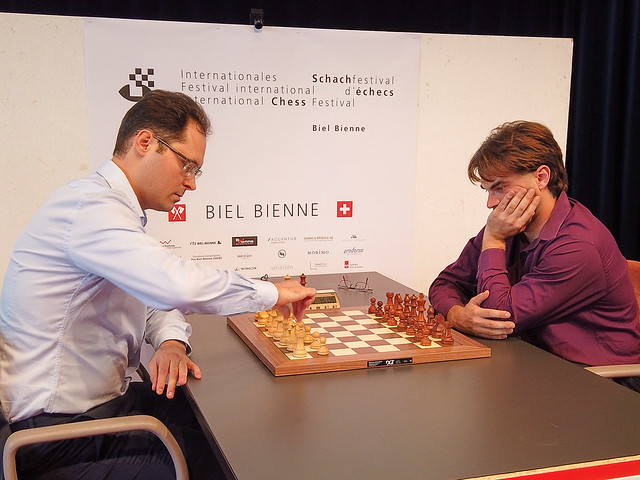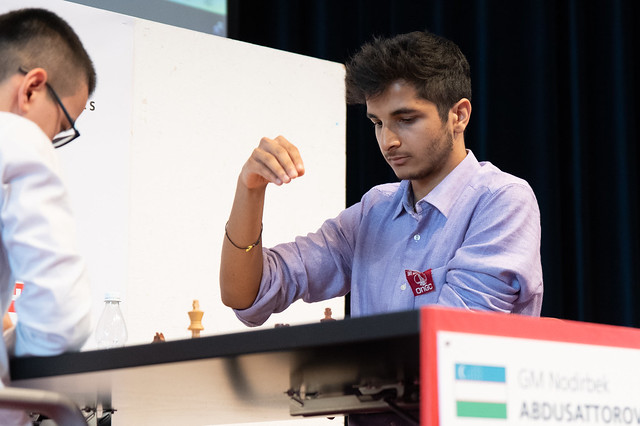Leko wins rapid portion of the "triathlon"
The 2019 Biel International Chess Festival kicked off with the rapid section in the Grandmaster Tournament. The format this year is rather unique: Eight grandmasters compete for the top place over a series of 28 games that include 7 classical, 7 rapid and 14 blitz encounters. The point tallies are weighted for the various formats:
- Classical: 3 points for a win; 1 point for a draw; 0 point for a loss
- Rapid: 2 points for a win; 1 point for a draw; 0 point for a loss
- Blitz: 1 point for a win; ½ point for a draw; 0 point for a loss
Peter Leko is known as one of the most solid players of the game, but what prevented him from winning a lot of major tournaments was his safety first approach. At his best however, he is a beast in the endgame, and the Biel Rapid witnessed his famous squeezes in full flow.

Peter Leko, the veteran in Biel | Photo: Simon Bohnenblust / Biel Chess Festival
We shall start by looking at a seemingly drawn endgame against Vidit:
These kinds of positions look deceptively simple to play — it seems all Black has to do for counterplay is to push his a-pawn as far as it can go and then trade it for one of White's passers (whenever one arises). However, sometimes it rains despite a clear blue sky. In rapids, what is necessary is a clear plan of action and I feel that this is something Vidit was missing here. The engine suggests a defence after ♞e8!, intending to meet ♖a8 with ♚e7, but I am not sure the position after ♖a7+ ♚e6 e4! is holdable with little time on the clock.
Vidit chose the far more natural 34...♚g7?!, but it allowed Peter to favourably regroup with 35.♔h3 and ♘g3. The important point being that ♔h3 cannot be met by ♜f2 as ♘g3 ♜xf3 ♔g2 traps the rook as ♞f5+ is coming. A further error cost Black the game.
 This DVD provides everything you need to know to be able to play one of the most classical openings with Black, the Nimzo-Indian, arising after 1.d4 Nf6 2.c4 e6 3.Nc3 Bb4. Nearly every World Championship and top tournament features the Nimzo-Indian.
This DVD provides everything you need to know to be able to play one of the most classical openings with Black, the Nimzo-Indian, arising after 1.d4 Nf6 2.c4 e6 3.Nc3 Bb4. Nearly every World Championship and top tournament features the Nimzo-Indian.Leko then went on to give Uzbek prodigy Abdusattorov a lesson in the art of accumulating small advantages:
White's position looks pretty, but he has no weaknesses to attack and his knights have no good squares. Leko has a clear plan of advancing his f-pawn to create threats on the kingside. He went on to convert in in 37 moves.
 The Colle-Koltanowski system is very easy to learn, yet an extremely dangerous opening.
The Colle-Koltanowski system is very easy to learn, yet an extremely dangerous opening.His third win was a nice counter-attacking game against the mercurial Jorge Cori:
After mutual errors, the players reached the following position. White's only chance for dynamic equilibrium lay in c5! sacrificing a piece, but shutting out the light squared bishop after fxe4 c6. Instead, Cori's move 27.d6? only worsened the situation and the game was over a move later.
Leko would have had a fourth win if not for some inaccurate play in the endgame against Maghsoodloo:
Peter should have played ♕a4! retaining some pressure after ♛e8 ♕b3! and it is not clear to my eyes how Black should equalise. Instead, his game move 22.♛c3 allowed Parham to slowly unravel and save a crucial point.
With an unbeaten +3, Peter now leads the tournament going into the classical section. The chess world is definitely a better place with him back to near his best! Perhaps this is a catalyst for Peter's return to the 2700 club and the revival of his playing career?

Beware Sam! The old generation is not gone just yet! | Photo: Simon Bohnenblust / Biel Chess Festival
Sam Shankland didn't quite start sprinting just yet, but some positions that he won serve as a frightful warning for his fellow competitors:
Nico's last chance of saving the game was ♜b6! trying to exchange a pair of rooks. Instead, after 40...♜d3? Sam won a pawn by force after 41.♗xe6! ♜xe6 42.♖cc7 and soon converted.
He then latched on Maghsoodloo's error late into an endgame:
White is close to a draw despite the pawn minus, due to both pawns being on the same side of the board. Had Maghsoodloo been precise here with ♕d7! he would have been able to defend successfully. Instead, 66.♔h2?? allowed ♛e5! with decisive threats, and the game was soon finished in Black's favour.
Despite winning two games, Sam could not catch up with Leko, who won one more. His technique in a few of the draws left a lot to be desired:
With Vidit struggling for form, Shankland should have capitalised here with ♝b6! and ♛d7, keeping firm control of proceedings. Instead, Sam went for it immediately with ♛b4?! and soon had to wriggle out with a piece sacrifice to force the draw.
With ♗c6! Sam could have obtained a nearly decisive advantage. The idea is to support the pawn from b7 while preventing the rook from blockading it on the a-file. White should soon win the Bishop for the pawn (♘d3-b4-c6 is just one of the ideas, the other is to run with the king to the queenside) and then the two pieces collect the weak kingside. 44.♗d3?! as played in the game was far weaker, and allowed Black to save it.
With 21 games still to go, there is enough time for Sam to get into top gear, but one thing is clear — he isn't the one and only favourite to win the tournament.

Sam finished runner-up in the rapid leg | Photo: Biel Tournament Page
Sam's hopes of winning the tournament are well and truly alive, but he will disappointed about not winning the rapid leg.
Vidit and Maghsoodloo managed to make it to shared third, while the rest of the participants struggled for consistency. Here are some interesting moments:
Bogner's torrid tournament is something to forget as soon as possible. Here his preparation was mixed up so bad that after the mistaken 9...♝d6? the shot 10.♘xd5! gives White a near decisive advantage. Instead, ♝e7! maintains a slightly worse, but defensible position.
Cori's oscillations continued with this game. Here he missed the cute shot f6! the point being that after ♜xg1 fxe7 ♜g2+ ♕xg2! he wins an exchange by force after hxg2 ♘f6!
It was essential to eliminate the knight with ♝xd7! retaining hopes of saving the game. Instead, Nodirbek allowed it to g5 after which it was impossible not to shed material. Cori made no further mistakes in converting.
Bogner played 53...a5??, a seemingly natural move, overlooking the deadly 54.c4! after which the pawn endgame that is forced after 54...♜b4 55.♖d6+! ♚e7 56.♖b6 is won. Instead, Kf6 was the best way to retain drawing chances.
16.♘xc6? lost an exchange after 16...♛xc6 17.♘d4 ♝xe2. Instead, a4 maintained a tense position with mutual chances.

Vidit had a topsy-turvy start but recovered towards the end | Photo: Simon Bohnenblust / Biel Chess Festival
Here the complex c6! would have saved the day for Bogner. Instead, the timid Qc2 allowed Vidit to take over with cxb6! and the Indian No.3 never looked back after that.
e2-e4 was played, allowing Black to take en-passant if he wanted to. According to me, Nico should have done so, as his game continuation Bb7 instantly lost an exchange after Bh3! Vidit smoothly converted after that.
Nico must have been short of time in the following crazy position, as he blundered to lose a dynamically balanced position:
Rd7! maintains the balance after subsequent accurate play. Instead, Qxh5, the most natural move in the position, loses instantly after Bxg5 hxg5 Qxe4+!.

Nodirbek pulled back no punches, and finished with 5.0/14. | Photo: Simon Bohnenblust / Biel Chess Festival
Final standings - Rapid
All rapid games
Links




























